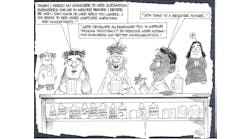Stan: We got a couple of good reasons from George Buckbee why a rotary control valve increased process variability even though the positioner said the step response was fine.
George: I have seen this same phenomenon several times, with at least two different causes. In both cases, bench-testing and setup could not have uncovered or prevented the problem. In the first case, a 9-in. valve was exhibiting this stiction cycle, despite a more-than-adequate positioner. Closer investigation revealed that the air supply was moving through a ¼-in. tube, running almost 200 ft back to the air header! There simply wasn’t enough air supply to make the valve move. This resulted in a classic stick-slip cycle, as the positioner pressure would eventually build up to make the valve move.
Technical BackupThe second case involved a butterfly valve in a line with a substantial pressure drop. The force exerted by the flow would push the valve open. The positioner was tuned while the process was down (no flow), so it wasn’t properly tuned for the actual operating conditions. When there was flow, the positioner tuning was not aggressive enough to control the valve position. This puzzler illustrates a very important principle in process and control performance: To get good performance, you need to measure and track the performance of the process, the controls, and the equipment under actual real-time operating conditions.
Greg: The positioner on many rotary valves uses actuator shaft-position feedback instead of ball or disk-stem position. The positioner doesn’t see friction in the sealing surfaces and packing and backlash in the connections between the stem and shaft. Also, the step size introduced in a test may be larger than the dead band from backlash or the resolution from stick-slip.
Controller Tuning Rules
Now, we’re going to talk controller tuning. Most astute control people can devise a case where using their favorite tuning method is best. The Handbook of PI and PID Controller Tuning Rules, 2nd edition, by Aidan O’Dwyer alone offers over 400 pages of tuning rule tables. To help put them all in perspective, I offer the following Top 10 list.
Top 10 Reasons to Devise
Your Own Tuning Rule and Simulation Test
10. Opportunity to present papers at your favorite conference
9. Material to start a blog site
8. Competitive edge to start a consulting business
7. Listing in a book on tuning rules
6. Method named after you (sorry, Ignatius Michael Coolman, the IMC acronym is taken)
5. Simulations tailored to prove your point
4. Linear processes without control valves
3. Speed, since the time to steady state is just a matter of seconds in your simulation
2. Simplicity gained by ignoring the prevalence, size, speed and entry point of unmeasured disturbances in real processes and nonstationary behavior
1. Chance to discount industrial online software for controller tuning as just hearsay
What prompted this impromptu column was the realization that diverse tuning rules have a common basis. For example, the equation for controller gain from the Ziegler Nichols ultimate oscillation, the Lambda self-regulating and integrating process, and the internal model control tuning rules, when set for maximum disturbance rejection (that is, maximum transfer of variability from the process-control variable to the controller output), all reduce to the Ziegler Nichols reaction curve rule. The focus here is on processes dominated by a large process time constant.
The controller gain per the Ziegler Nichols reaction curve rule with the gain cut in half per the industrial practice to increase smoothness and robustness is:
Kc = 0.5 / (R * L)
The figure used by Ziegler Nichols for the graphical estimation of R and L showed the process initially lined out, so R is the ramp rate in %/minutes divided by the change in manual controller output. For integrating and disturbance-prone self-regulating processes, the initial ramp rate isn’t zero. If you use the change in ramp rate before and after the change in controller output, R becomes the integrating process gain used in the Lambda integrating process tuning rule and the shortcut tuning method in Good Tuning–A Pocket Guide. Furthermore, if you realize that the process gain (Kp) divided by the process time constant (Tp) is the integrating process gain (Ki) for a slow self-regulating process, you can convert back and forth between the Ziegler Nichols equation and the common equation seen in the literature:
Kc = 0.5/(Ki*Td) = (0.5*Tp) / (Kp*Td)
If you use process dead time (Td) as the Lambda in the Lambda self-regulating and integrating process tuning rules, you get the above equations, but with a larger coefficient for the integrating process rule. Part of the conceptual hurdle is visualizing the initial response before the inflection point of a slow self-regulating process as the ramp rate of an integrating process. For controllers tuned for fast disturbance rejection, the controller works off only the initial part of the response.
The integrating process gain (Ki or R) is very small or, equivalently, the process time constant (Tp) is very large relative to the dead time (Td) for temperature, composition, and gas pressure control of well-mixed volumes. For temperature loops on columns, evaporators, crystallizers and reactors, the process time constant is typically 10 times larger than the dead time. Users can choose very high controller gain or tight control. However, this assumes rapid movement of the controller output doesn’t upset the operator or other loops.
The integrated absolute error (IAE) for a disturbance is proportional to the integral time divided by the product of the process gain and controller gain for a non-oscillatory response. If the controller is tuned for maximum load rejection, the IAE is proportional to the dead time squared divided by the process time constant. A large time constant in the process slows the excursion rate of the actual process variable disturbances, and allows the controller to catch up with the disturbance.
The relationships for controller tuning and performance work no matter where the largest time constant is located. If it’s in the measurement, the measured process variable looks good, but the actual has gone off to parts unknown. If it’s in a sensor, transmitter or signal filter, it gives the illusion of good control, but is merely an attenuated version of the real world. A large time constant in the measurement converts part of the next smaller time constant in the loop to dead time. Dead time slows down the ability of the controller to see and compensate for disturbances (see Control Talk,” Aug. ’06).
Some confusion comes from the varied nomenclature and lack of detail for the three parameters used for a first-order-plus-dead-time model of a self-regulating process response. The process gain for controller tuning is a dimensionless static or steady-state gain that’s actually the product of the final-element gain, process gain and measurement gain (100%/span) for the controller in manual. It’s the final change in the process variable in percent divided by the change in manual controller output in percent, assuming no disturbances. I prefer to call it an open loop gain (Ko).
This Month's Puzzler
If a controller is tuned with a Lambda factor of 2, and the total loop dead time is one-tenth of the largest time constant in the loop, what wireless communication interval would start to cause a degradation in load response? Send an e-mail with your answer, questions, or comments to The Puzzler.
The process time constant is the largest time constant in the loop for a change in manual controller output. I call it the open-loop time constant (To) to distinguish it from the closed-loop time constant, which is the time constant for a set point change with the controller in automatic. A time constant is the time to reach 63% of the final change after the loop dead time.
The process dead time is the total dead time in the loop, or the time to the start of a distinguishable response in the process variable after the change in controller output. Sometimes the total loop dead time is called the “delay,” and the open loop time constant is called the “lag.”
| About the Author |
Greg McMil and Stan Weiner, PE bring their wits and more than 66 years of process control experience to bear on your questions, comments and problems. Write to them at [email protected].
Click the Download Now button below for technical backup for this article.




